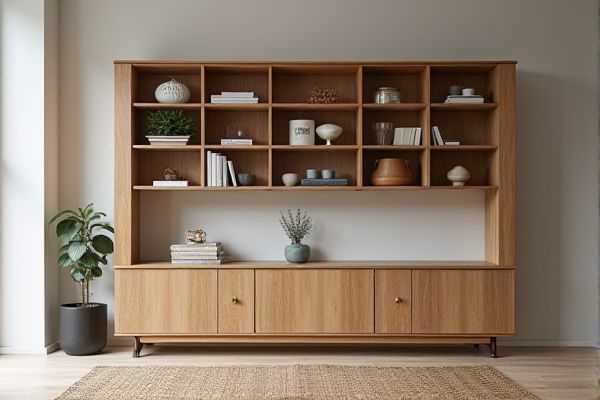
Open shelf credenzas offer easy access and visibility for displaying items, ideal for decorative purposes, while closed credenzas provide concealed storage that keeps your space tidy and protects belongings from dust. Explore the rest of the article to discover which type of credenza best suits your storage needs and style preferences.
Table of Comparison
| Feature | Open Shelf Credenza | Closed Credenza |
|---|---|---|
| Storage Access | Easy, quick access to items | Items stored out of sight |
| Visibility | Visible shelves and contents | Concealed storage with doors/drawers |
| Protection | Minimal protection from dust or damage | Better protection against dust and damage |
| Design Style | Modern, minimalist, casual look | Classic, formal, organized appearance |
| Maintenance | Requires frequent dusting | Less frequent cleaning needed |
| Use Case | Display books, decor, and frequently used items | Store office supplies, confidential items, and clutter |
| Typical Materials | Wood, metal, glass with open shelving | Wood, laminate, metal with doors/drawers |
| Cost Range | Generally lower priced | Moderate to higher price due to complexity |
Introduction to Credenzas: Open Shelf vs Closed
Open shelf credenzas provide easy access and visibility, making them ideal for displaying decor and frequently used items in offices or living spaces. Closed credenzas offer concealed storage, protecting contents from dust and creating a cleaner, more streamlined appearance suitable for professional or minimalist environments. Choosing between open shelf and closed credenzas depends on the balance desired between accessibility, display, and organization.
Defining Open Shelf Credenzas
Open shelf credenzas feature exposed shelving that allows easy access and display of items, offering a visually light and airy storage solution ideal for showcasing decor or frequently used objects. Unlike closed credenzas, they lack doors or panels, promoting organization through visible compartments while enhancing a room's openness. Your choice between open shelf and closed credenzas depends on the need for display versus concealment of belongings.
Defining Closed Credenzas
Closed credenzas feature doors or panels that conceal storage compartments, providing a clean and organized appearance by hiding clutter away from view. This design enhances your room's aesthetic by maintaining a streamlined look while protecting contents from dust and damage. Unlike open shelf credenzas, closed credenzas offer increased privacy for valuable items and contribute to a more formal or minimalist decor style.
Visual Appeal and Aesthetic Differences
Open shelf credenzas enhance visual appeal by showcasing decor items and creating an airy, spacious look, while closed credenzas offer a sleek, minimalist aesthetic by concealing storage clutter. Your choice influences room ambiance, with open shelves adding personality through displayed objects, and closed designs providing a clean, streamlined finish. Both styles complement modern interiors but cater to different preferences for visibility and organization.
Storage Capacity and Organization
An open shelf credenza offers easy access and visibility, making it ideal for frequently used items and decorative displays while limiting concealed storage options. A closed credenza provides greater storage capacity and organization through drawers and cabinets, enabling better protection for items and reducing visual clutter. Choosing between the two depends on the balance between accessibility, privacy, and the need to organize office or home essentials effectively.
Accessibility and Convenience
An open shelf credenza offers quick and easy access to your items, making it ideal for frequently used office supplies or decorative pieces, while a closed credenza provides a clutter-free appearance by concealing contents behind doors or drawers, enhancing organization. Open shelves enhance visibility, allowing you to locate and retrieve items faster, but they may require more frequent tidying to maintain a neat look. Closed credenzas protect your belongings from dust and offer more privacy, which is convenient for storing sensitive documents or personal items out of sight.
Best Uses for Open Shelf Credenzas
Open shelf credenzas are ideal for displaying decorative items, books, and frequently accessed materials, making them perfect for living rooms, home offices, and creative spaces. Their open design promotes easy organization and quick retrieval, enhancing both functionality and aesthetics. You can use an open shelf credenza to showcase your personal style while keeping essentials within arm's reach.
Best Uses for Closed Credenzas
Closed credenzas are ideal for secure storage of sensitive documents and office supplies, providing a clutter-free workspace by concealing items behind doors or drawers. They are best used in professional environments where privacy and organization are paramount, such as executive offices or conference rooms. Their enclosed design also helps protect contents from dust and damage, making them practical for long-term storage.
Maintenance and Cleaning Considerations
Open shelf credenzas require more frequent dusting and cleaning due to exposed surfaces that accumulate dust and debris quickly, making maintenance more time-consuming. Closed credenzas protect belongings from dust and stains, reducing the frequency of cleaning and helping preserve your items in better condition. Choosing a closed credenza can simplify upkeep, especially in high-traffic or dusty environments where cleanliness is a priority.
Choosing the Right Credenza for Your Space
Open shelf credenzas offer easy access and display opportunities for books, decor, and frequently used items, making them ideal for living rooms and offices where aesthetics and convenience matter. Closed credenzas provide concealed storage, protecting belongings from dust and clutter, suited for formal settings or spaces requiring a tidier, minimalist appearance. Selecting the right credenza depends on balancing visibility with functionality, taking into account room size, storage needs, and design preferences.
 homyna.com
homyna.com